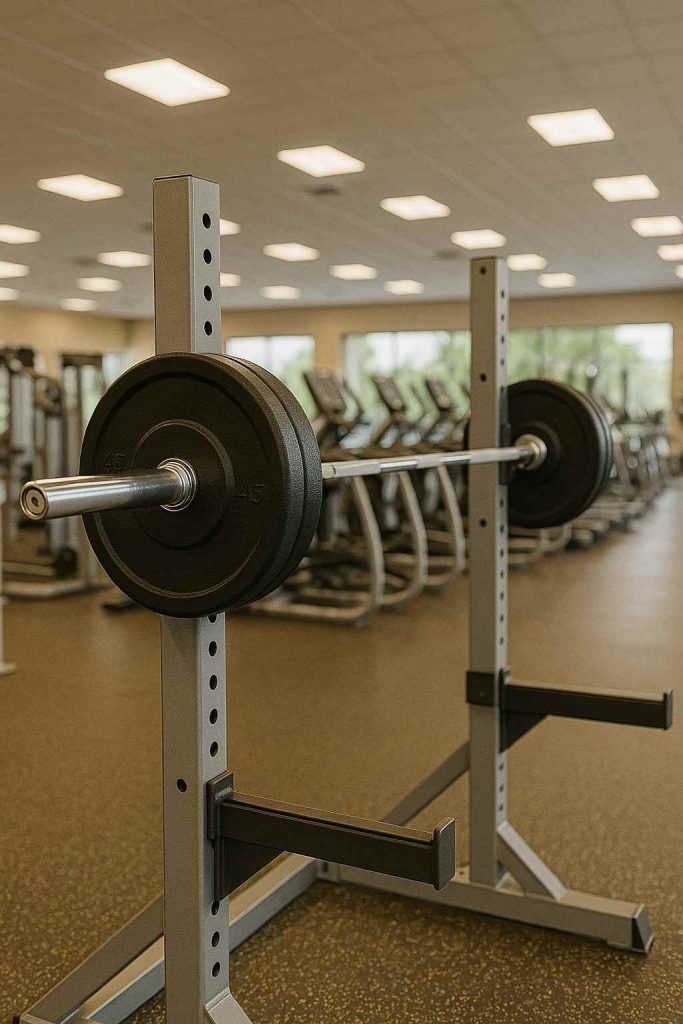A standard Olympic squat bar weighs 20 kg (44 lb) for men and 15 kg (33 lb) for women. Understanding squat bar weight is crucial because it ensures you track your lifts accurately and avoid potential injuries. Whether you’re new to lifting or an experienced athlete, knowing the exact bar weight and the different types available helps you select the right equipment for your workouts and training goals. Most commercial gyms use the standard Olympic bar, but specialty squat bars can vary widely in weight and features. In this article, you’ll find all the key squat bar weights, what makes each type unique, and how to choose the best option for your training.

Types of Squat Bars and Their Weights
Standard Olympic Squat Bar Weight
- Men’s Olympic Bar: 20 kg (44 lb)
- Women’s Olympic Bar: 15 kg (33 lb)
- Length: 7 ft (men’s), 6.5 ft (women’s)
- Diameter: 28–29 mm (men’s), 25 mm (women’s)
These bars are commonly found in gyms worldwide. Most powerlifting competitions also use the 20 kg Olympic bar as standard for men. Always check the end cap of your barbell or ask staff to confirm its weight.
Source: USA Weightlifting, Shape Magazine (2024)
Safety Squat Bar
- Typical Weight: 25–34 kg (55–75 lb)
- Key Features: Padded yoke, cambered design, front handles
Safety squat bars (SSB) are designed to reduce shoulder stress and make squatting safer for those with mobility limitations. Because of their extra padding and construction, SSBs are heavier than Olympic bars.
Source: PowerliftingTechnique.com (2024), DMoose Blog (2024)
Cambered Squat Bar
- Typical Weight: 38.5 kg (85 lb)
- Key Features: Large curved or “cambered” frame, shifts center of gravity
Cambered bars are specialty bars often used by advanced lifters. The extra weight and unique balance challenge stability, core, and technique.
Source: SetGraph App (2024), PowerliftingTechnique.com (2024)
Trap Bar (Hex Bar)
- Typical Weight: 20–30 kg (44–65 lb)
- Key Features: Hexagonal shape, used for deadlifts and squats
Trap bars can vary by manufacturer, so always check for an engraved or labeled weight. They’re versatile for lower body and full-body lifts.
Source: Shape Magazine (2024)
Technique/Training Bar
- Typical Weight: 7–11 kg (15–25 lb)
- Key Features: Lightweight, often aluminum or thin steel
These bars are ideal for beginners and those working on perfecting form without heavy loads. They help lifters learn proper technique safely.
Source: SetGraph App (2024)
Why Does Squat Bar Weight Matter?
- Accuracy in Tracking: Always count the bar’s weight when calculating your total lift. Not all bars weigh the same—double-check before logging your sets.
- Progression: Correctly logging both bar and plate weight is essential for progressive overload and safe gains.
- Safety: Specialty bars like the safety squat bar can reduce injury risk and support people with limited mobility or shoulder problems.
- Competition: If you plan to compete, train with the bar type and weight used in your target federation.
Tip: Most commercial gym bars are labeled. If not, ask gym staff or weigh the bar on a gym scale.
Recent Update: Some gyms now offer custom or branded bars. Their weight can differ from traditional Olympic specs—always verify before starting a new program (PowerliftingTechnique.com, 2024).
Quick Reference Table: Squat Bar Weights
| Bar Type | Typical Weight | Use Case |
|---|---|---|
| Olympic (Men’s) | 20 kg (44 lb) | Standard squats, powerlifting, competitions |
| Olympic (Women’s) | 15 kg (33 lb) | Standard squats, weightlifting |
| Safety Squat Bar | 25–34 kg (55–75 lb) | Safer squats, injury prevention |
| Cambered Squat Bar | 38.5 kg (85 lb) | Advanced, stability training |
| Trap/Hex Bar | 20–30 kg (44–65 lb) | Deadlifts, full-body lifts |
| Technique/Training Bar | 7–11 kg (15–25 lb) | Beginners, technique work |
Frequently Asked Questions
Q: Do all gym squat bars weigh the same?
A: No. While many gyms use the standard 20 kg Olympic bar, specialty bars and off-brand bars may differ. Always check before lifting.
Q: Can I use a lighter bar if I’m a beginner?
A: Yes! Technique bars are designed for learning proper movement without heavy weight.
Q: Why do safety squat bars weigh more?
A: They have extra padding, a thicker frame, and unique handles, which increase the weight but improve comfort and safety.
Q: Where can I check my gym’s bar weight?
A: Look for weight markings on the bar end, or ask gym staff. If unsure, weigh the bar on a gym scale.
Conclusion
Knowing how much a squat bar weighs—and the differences between types—keeps your training accurate, safe, and effective. From the standard 20 kg Olympic bar to heavier specialty bars, always confirm the bar’s weight before your sets. Choose the best bar for your skill level, goals, and safety needs. Ready to lift smarter? Double-check your equipment, log every rep, and keep making gains!
